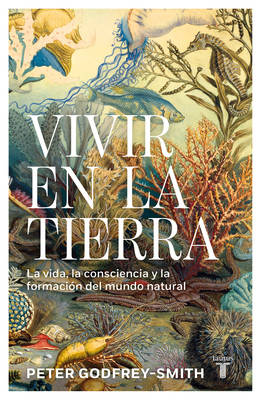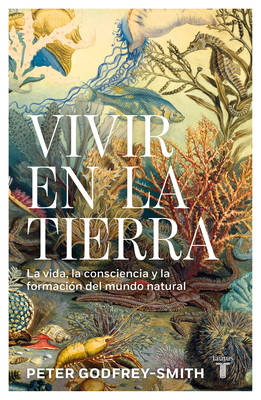
- Retrait en 2 heures
- Assortiment impressionnant
- Paiement sécurisé
- Toujours un magasin près de chez vous
- Retrait gratuit dans votre magasin Club
- 7.000.0000 titres dans notre catalogue
- Payer en toute sécurité
- Toujours un magasin près de chez vous
Vivir En La Tierra: La Vida, La Consciencia Y La Formación del Mundo Natural / Living on Earth
Peter Godfrey-Smith
Livre broché | Espagnol
34,95 €
+ 69 points
Description
Vuelve el autor de Otras mentes con un ensayo fascinante y revelador sobre lo que une a todos los habitantes de la Tierra.
Si la historia de la Tierra se redujera a un año, nuestra especie surgiría en los últimos treinta minutos. Pero la vida ha existido durante 3.700 millones de años, la mayor parte de la historia de nuestro planeta y más de una cuarta parte de la edad del universo. ¿Qué hicieron esos organismos durante todo este tiempo? Impulsado por esta cuestión, el filósofo y submarinista Peter Godfrey-Smith se pregunta en su nuevo libro cómo la vida fue moldeada y moldeó la Tierra, y nos invita a un fascinante recorrido por su historia. Visitaremos a gorilas ruandeses y pájaros australianos, bucearemos arrecifes de coral y guaridas de pulpos, consideraremos el impacto del lenguaje y la escritura para el planeta, y sopesaremos las responsabilidades que conllevan nuestros poderes únicos, en relación con la agricultura industrial, la conservación del hábitat, el cambio climático y el uso de animales en experimentos. Desde los mares hasta los bosques, desde la primera aparición de la materia animada hasta su futura extinción, el autor nos ofrece una asombrosa visión del curso de la vida en la Tierra y de cómo podríamos afrontar los retos de nuestro tiempo. Los humanos pertenecemos a un sistema infinitamente complejo y nuestra mente es producto de ese sistema, pero también somos una fuerza capaz de modificar el mundo en el que vivimos. Somo criaturas de la Tierra, tenemos el futuro de la Tierra en nuestras manos. ENGLISH DESCRIPTION The author of Other Minds returns with a fascinating and revealing essay about what unites all the inhabitants of Earth.
If the history of Earth were reduced to a single year, our species would emerge in the last thirty minutes. Yet life has existed for 3.7 billion years--most of our planet's history and more than a quarter of the age of the universe. What were those organisms doing all that time? Driven by this question, philosopher and diver Peter Godfrey-Smith asks in his new book how life was shaped by the Earth and how it, in turn, shaped the planet. He invites us on a fascinating journey through its history. We will visit Rwandan gorillas and Australian birds, dive into coral reefs and octopus dens, consider the impact of language and writing on the planet, and weigh the responsibilities that come with our unique powers in relation to industrial agriculture, habitat conservation, climate change, and the use of animals in experiments. From the seas to the forests, from the first emergence of living matter to its possible future extinction, the author offers us a stunning vision of the course of life on Earth and how we might face the challenges of our time. Humans belong to an infinitely complex system, and our minds are products of that system--but we are also a force capable of altering the world we live in. We are creatures of the Earth, and the future of the Earth lies in our hands.
Si la historia de la Tierra se redujera a un año, nuestra especie surgiría en los últimos treinta minutos. Pero la vida ha existido durante 3.700 millones de años, la mayor parte de la historia de nuestro planeta y más de una cuarta parte de la edad del universo. ¿Qué hicieron esos organismos durante todo este tiempo? Impulsado por esta cuestión, el filósofo y submarinista Peter Godfrey-Smith se pregunta en su nuevo libro cómo la vida fue moldeada y moldeó la Tierra, y nos invita a un fascinante recorrido por su historia. Visitaremos a gorilas ruandeses y pájaros australianos, bucearemos arrecifes de coral y guaridas de pulpos, consideraremos el impacto del lenguaje y la escritura para el planeta, y sopesaremos las responsabilidades que conllevan nuestros poderes únicos, en relación con la agricultura industrial, la conservación del hábitat, el cambio climático y el uso de animales en experimentos. Desde los mares hasta los bosques, desde la primera aparición de la materia animada hasta su futura extinción, el autor nos ofrece una asombrosa visión del curso de la vida en la Tierra y de cómo podríamos afrontar los retos de nuestro tiempo. Los humanos pertenecemos a un sistema infinitamente complejo y nuestra mente es producto de ese sistema, pero también somos una fuerza capaz de modificar el mundo en el que vivimos. Somo criaturas de la Tierra, tenemos el futuro de la Tierra en nuestras manos. ENGLISH DESCRIPTION The author of Other Minds returns with a fascinating and revealing essay about what unites all the inhabitants of Earth.
If the history of Earth were reduced to a single year, our species would emerge in the last thirty minutes. Yet life has existed for 3.7 billion years--most of our planet's history and more than a quarter of the age of the universe. What were those organisms doing all that time? Driven by this question, philosopher and diver Peter Godfrey-Smith asks in his new book how life was shaped by the Earth and how it, in turn, shaped the planet. He invites us on a fascinating journey through its history. We will visit Rwandan gorillas and Australian birds, dive into coral reefs and octopus dens, consider the impact of language and writing on the planet, and weigh the responsibilities that come with our unique powers in relation to industrial agriculture, habitat conservation, climate change, and the use of animals in experiments. From the seas to the forests, from the first emergence of living matter to its possible future extinction, the author offers us a stunning vision of the course of life on Earth and how we might face the challenges of our time. Humans belong to an infinitely complex system, and our minds are products of that system--but we are also a force capable of altering the world we live in. We are creatures of the Earth, and the future of the Earth lies in our hands.
Spécifications
Parties prenantes
- Auteur(s) :
- Editeur:
Contenu
- Nombre de pages :
- 328
- Langue:
- Espagnol
Caractéristiques
- EAN:
- 9786073861045
- Date de parution :
- 03-02-26
- Format:
- Livre broché
- Format numérique:
- Trade paperback (VS)
- Dimensions :
- 150 mm x 230 mm
- Poids :
- 367 g

Seulement chez Librairie Club
+ 69 points sur votre carte client de Librairie Club
Les avis
Nous publions uniquement les avis qui respectent les conditions requises. Consultez nos conditions pour les avis.







